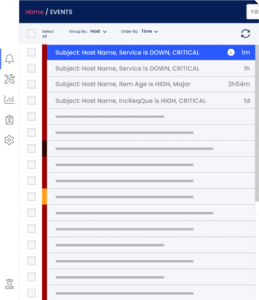There are many computing resources used in different cloud application services to provide online software-as-a-service (SaaS). SaaS differs from traditional applications in that it works from a cloud computing environment. This means that both the application service as well as user data are being hosted by a cloud provider in the cloud. Therefore, the SaaS and data are accessible from anywhere as long as there’s online access. This model provides a distinct advantage from a software perspective. For instance, new application services can be created by adapting ones that already exist, all the while masking the intricacies of the basic implementation. The cloud offers widespread access to many software services that are reusable. This, in turn, encourages and enables increased development of other applications.
As it’s challenging to manage cloud applications, we need controllability and observability to help us in our efforts.
Controllability & Observability: Definition
Controllability
Think of controllability as “acting.” The definition of controllability is to be able to fix a system when it deviates from its intended state or else needs to adapt itself to changes stemming from the environment or management process. Essentially, controllability describes the ability of an external factor to influence a system’s internal state and effect change from one state to another in a specific period of time.
Observability
Observability can be seen as “looking.” Observability is really our eyes and ears; you can answer any questions about what’s going on inside of the system by simply observing the outside of it – even without shipping new code to answer new questions. Observability is the answer to the increasing complexity we face and how it is outpacing our ability to foresee what’s going to stop working.
Two sides of the same coin?
Controllability and observability are two sides of the same problem. It’s vital for the cloud application’s performance (or, in contrast, inactivity) to be visible. If any interventions are necessary, the team needs to be able to implement the proper changes. However, the reality is that, currently, many developers of cloud applications lack these two principles, controllability and observability, in their development cycle. Consequently, they are facing a prevalence of certain challenges that call for a solution.
Therefore, a deeper understanding of these two principles of controllability and observability – and how to apply them – can considerably enhance the cloud application development cycle.
Both controllability and observability can significantly improve the cloud application development cycle and aid in our efforts to better understand performance vs. latency. In fact, both aspects are vital components in monitoring. For example, we monitor the application’s performance versus latency first through observation. Then, we correct anything that’s needed by means of control.
Observability is a vital part of any solution. It offers assistance for customers to adapt to growing change rates or increased complexity. However, for observability to be effective and efficient, it must be understood and managed in relation to the following aspects: monitoring, controllability, and management. Controllability follows observability, and involves creating an environment that is controlled in which numerous coders can ensure and sustain a smooth lifecycle of software delivery. For controllability to happen, observing must first happen.
Both aspects are integral parts of a response loop that assists and improves the cloud application development cycle, which faces numerous challenges still today.
Challenges in Cloud Application Development
There are a number of challenges currently faced in cloud application development:
- As monitoring platforms need to handle and aggregate more and more data at higher frequencies, the chances increase that errors fall through the cracks.
- There is an increasing amount of application components available. This leaves IT Ops and developers overwhelmed by the large amounts of alerts and metrics they must monitor, making it increasingly hard to see the “big picture.”
- The release of updates that lack proper and contextual aggregated data means that changes are being made with inaccurate or no understanding of current issues. This results in valuable time and resources being wasted without improvements being made to problems that were personally experienced.
These particular challenges are specifically associated with the testing and quality of cloud applications. They could potentially be solved by using more controllability and observability regarding the development cycle.
Advantages of Controllability and Observability
Properly implementing controllability and observability has numerous benefits, primarily:
By aggregating all of your dashboards, components, and data into one place, your developers can get a holistic understanding of all relevant alerts as well as a big picture of the system’s health and status.
It is more effective since its approach is more open, thereby offering complete transparency to all operations teams and developers of any domain. This, in turn allows access and tools in a manner that’s more user-friendly, which increases the number of people available and able to solve issues and bugs.
It allows IT Ops to make more informed decisions since it has the tools to offer a closer look into the issue at hand and pinpoint it directly. Plus, observability explains a system disruption, providing the ability to trace it back to its origins and view what occurred along the way. This ensures that the updated version solves the problem where it started instead of only where the problem was identified (which may differ).
In summary, it enables a comprehensive understanding of the system, full transparency and sharing of information, increased efficiency, the ability to explore specific issues at depth while monitoring every the system at all times.
How to Successfully Apply Controllability and Observability
When it comes to system monitoring, it is critical to ensure that the system is operating the way it was designed to at all times. To carry out an effective solution for controllability and observability, the following layers should be considered:
- Infrastructure and custom application monitoring
- Log analytics
- Application monitoring (APM)
- Visualization
- Alerts correlation
- End-to-end operational and alert management platform
An effective system will offer added value in the form of an extra layer of monitoring, where IT Ops can have access to a comprehensive “big picture” of production issues and an application. This can happen by the aggregation and display of analytics, logs, traces and alerts in one place, which enables the IT Ops to fix issues, pinpoint where the problems occur, better understand them, and improve overall services.
By being proactive, one can potentially foresee any potential issues before they may occur. Doing so will help identify and solve issues regarding production. It can also help increase the pace of the processes and releases, plus the ability to track and update any changes.
To achieve this at the NOC level, we want the ability to efficiently manage the NOC environment with the development and customer deployment of the cloud application.
That’s where our CloudOps Management Platform comes in; a SaaS-based SRE/NOC management platform that centralizes and manages all aspects of your operational environments.
Important qualities:
- Production-centralized knowledge-base management
- A single dashboard for all monitoring platforms
- Runbook automation (RBA) – may sometimes be referred to as “playbook automation”
- Production reports and BI analysis
- Robust escalation policies
- Smart event correlation
All of these listed qualities help to more closely observe and control the development and deployment of the cloud application. Consequently, the end result will be more customers will receive cloud application of higher quality.


